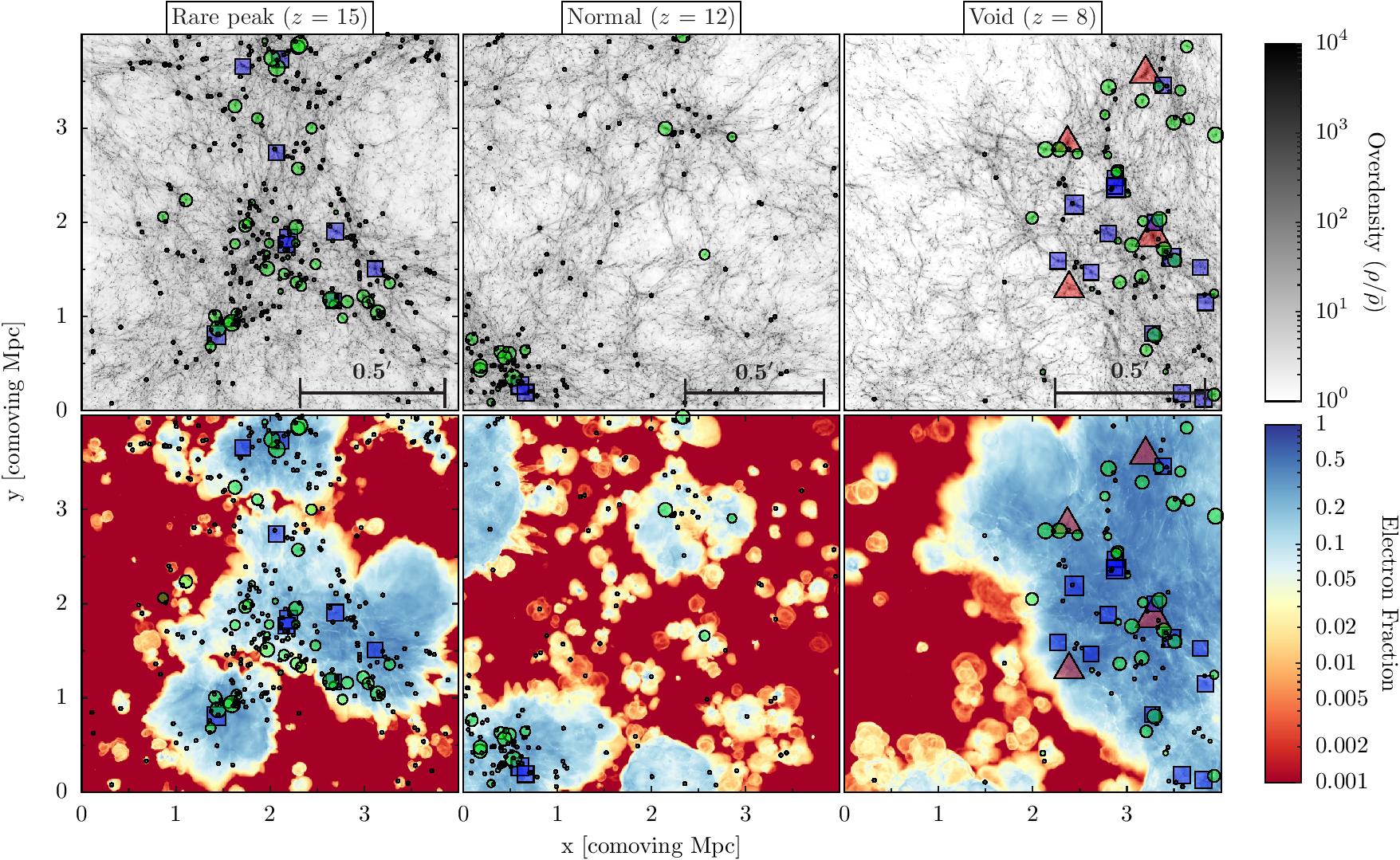The Universe May be Less Crowded than We Think

Matter overdensity (top row) and ionized fraction (bottom row) for the three regions simulated in the Renaissance Simulations. The red triangles represent the locations of galaxies that are detectable with the Hubble Space Telescope. Its successor, the James Webb Space Telescope, will detect many more distant galaxies, shown by the blue squares and green circles. These first galaxies reionized the universe only 1 billion years after the Big Bang, shown in the image with ionized (blue) bubbles around the g
There may be far fewer galaxies further out in the universe than might be expected, suggests a new study based on simulations conducted on the Blue Waters supercomputer at the National Center for Supercomputing Applications and supported by the Georgia Institute of Technology.
The study, which was published July 1 in Astrophysical Journal Letters and led by Michigan State University, shows the first results from the Renaissance Simulations, a suite of extremely high-resolution adaptive mesh refinement (AMR) calculations of high redshift galaxy formation.
The simulations show hundreds of well-resolved galaxies, allowing researchers to make several novel and verifiable predictions ahead of the October 2018 launch of the James Webb Space Telescope (JWST), a new space observatory that succeeds the Hubble Space Telescope.
“The Hubble Space Telescope can only see what we might call the tip of the iceberg when it comes to taking inventory of the most distant galaxies,” said San Diego Supercomputer Center (SDSC) Director Michael Norman, who was part of the study’s research team. “A key question is how many galaxies are too faint to see. By analyzing these new, ultra-detailed simulations, we find that there are 10 to 100 times fewer galaxies than a simple extrapolation would predict.”
“Our work suggests that there are far fewer faint galaxies than one could previously infer,” said principal investigator and lead author Brian O’Shea, an associate professor at Michigan State. “Observations of high redshift galaxies provide poor constraints on the low-luminosity end of the galaxy luminosity function, and thus make it challenging to accurately account for the full budget of ionizing photons during that epoch.”
Georgia Tech Assistant Professor John Wise wrote the code that made the simulations possible on Blue Waters. He also interpreted the data to make predictions for the JWST, serving as a “simulation architect” by setting the simulation parameters.
Wise and his fellow researchers found that the ultraviolet luminosity function of the simulated galaxies is consistent with observations of redshift galaxy populations at the bright end of the luminosity function and essentially flat rather than rising steeply at lower luminosities.
“The flattening at lower luminosities is a key finding in the study and significant to researchers’ understanding of the reionization of the universe, when the gas in the universe changed from being mostly neutral to mostly ionized,” said Wise, Dunn Family Assistant Professor in Georgia Tech’s School of Physics.
The term ‘reionized’ is used because the universe was ionized immediately after the fiery Big Bang. During that time, ordinary matter consisted mostly of hydrogen atoms with positively charged protons stripped of their negatively charged electrons. Eventually, the universe cooled enough for electrons and protons to combine and form neutral hydrogen. They didn’t give off any optical or UV light, and without that light astrophysicists aren’t able to see traces of how the cosmos evolved during these dark ages using conventional telescopes. The light returned when reionization began.
Because these simulations are so costly to generate, the team moved the entire output of the Renaissance Simulations to SDSC Cloud– some 100 terabytes of data, or the equivalent of about 150,000 audio compact discs. “A data access portal is being set up so that others can investigate their properties in more detail,” added Norman, also a distinguished professor of physics at UC San Diego and a faculty member with the Center for Astrophysics & Space Sciences at the university.
The results are detailed in the paper, titled Probing the Ultraviolet Luminosity Function of the Earliest Galaxies with the Renaissance Simulations.
In an earlier paper, simulations conducted by two researchers who were part of this new study concluded that about 300 million years after the “Big Bang,” the universe was 20 percent ionized, 50 percent ionized at 550 million years, and fully ionized at 860 million years after its creation.
While the James Webb Space Telescope will give cosmic researchers the ability to view and record substantial numbers of galaxies, the telescope has a relatively small field of view, according to the researchers. As a result, interpretation of any JWST survey must by necessity take into account cosmic variance – the statistical variation in the number of galaxies from place to place. A deeper understanding based on theory may be necessary to correctly interpret high redshift survey results.
The simulations were done on the National Science Foundation-funded Blue Waters supercomputer, one of the largest academic supercomputers in the world.
The research team also included Hao Xu, a postdoctoral research associate with the Center for Astrophysics & Space Sciences, at the University of California, San Diego. The research was funded by the National Science Foundation and NASA.